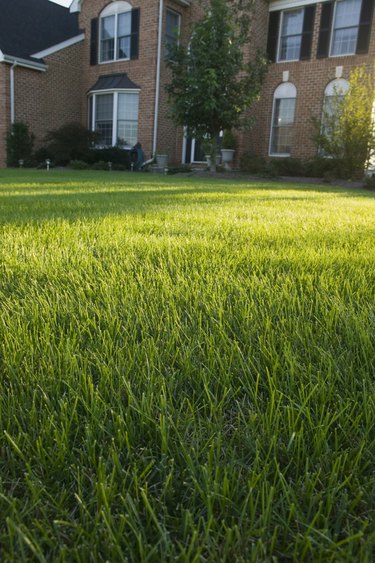
Not all grass seeds germinate at the same rate. Some seeds may fail to grow at all. The seeds' inability to develop causes a newly planted lawn to take on a patchy appearance. Overseeding the lawn with new grass seeds can take care of the unsightly appearance. A newly planted lawn can also suffer a patchy appearance from excessive foot traffic, lack of adequate water or poor soil nutrients. A new lawn can also succumb to disease.
Fertilizer
Video of the Day
An excessively enthusiastic gardener can overfertilize a new lawn. Applying too much fertilizer to one location can burn the delicate grass. Nitrogen will readily burn the grass's blades. Irrigate the patch of brown grass abundantly. Wait approximately one month; if the lawn does not fill in naturally, reseed the area. Excessive dog urine can also cause a dead patch to occur in the lawn. Treat the affected areas the same way as a nitrogen fertilizer burn.
Video of the Day
Foot Traffic
Foot traffic on a new lawn can quickly generate a bare area. The newly emerging grass blades will suffer damage from tromping. The soil will also become compacted, which makes it difficult for the root system of newly planted grass to grow. Aerate the soil in the patchy areas and replant new grass seed. Keep people and pets off the freshly planted grass until it has firmly established itself.
Water
Grass seeds need moisture to germinate. Avoid drowning the seeds, but keep them lightly moist until the grass begins to sprout. Keeping the soil uniformly moist will help the seeds successfully develop. Once the grass has begun to manifest itself, avoid overwatering it. Too much water will kill the root system and cause it to rot. Avoid allowing the water to pool on the soil during irrigation. The water pooling on the soil's surface may cause dead patches to begin to form in the lawn.
Disease
A newly planted lawn can suffer from fungal infections under certain weather and environmental conditions. Summer patch, caused by the fungus Magnaporthe poae, occurs during the warm summer months. A newly planted lawn may take on a patchy appearance if the fungus strikes. The Rhizoctonia solani fungus also develops during warm, moist weather. Powdery mildew favors grass planted in shady locations. Using fungicides may help control fungal lawn infections and reduce the patchy areas.